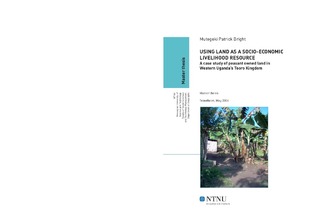Using land as a socio-economic livelihood resource: A case study of peasant owned land in Western Uganda’s Tooro Kingdom
Master thesis
Permanent lenke
http://hdl.handle.net/11250/265264Utgivelsesdato
2006Metadata
Vis full innførselSamlinger
- Institutt for geografi [1023]
Sammendrag
This thesis concerns the utilization of land as a socio-economic livelihood resource. Based on a case study of peasant owned land in Tooro Kingdom, different uses to which land is put are studied in relation to their importance to people’s efforts towards sustaining livelihoods. An underlying thinking is that current ways in which the resource is being used do not necessarily exhaust all its potential.Therefore, there is a possibility that the socio-economic productivity of the resource can be enhanced through finding solutions to the challenges being faced in its use.
A sustainable livelihood framework is used together with realism theory to give the study a theoretical background. Here, land is viewed as a natural resource whose livelihood potential can be utilized depending on not only people’s capacity to identify that value and continuously utilize it for their benefit, but also based on factors beyond the control of the individual land users or owners. A qualitative research methodology was the main tool for generating research materials during the research process. Emphasis in this was laid on research interviews, fieldwork observations and a study of secondary research sources with a questionnaire being used in situations where it was preferred to interviews by respondents.
The findings show that some peasant owned land in the study area is being used for socio-economic livelihood purposes. These range from either subsistence or commercial uses to a combination of both. The findings also show that the application to which this land is put and the derived benefits are both affected by factors including those linked to the land user/owner’s capacity to utilize the resource, land’s ability to respond positively to the uses to which it is put as well as the general conditions within which the resource is used. It is also shown that it is important to attend to challenges faced in the use of peasant owned land if its livelihood productivity is to be enhanced.
The study concludes that one of the main socio-economic uses of peasant owned land as a livelihood resource in the study area is in the agricultural production of food stuffs needed to feed the growing population. Land is also vital as a physical ground on which to set up human settlements. Other uses including quarrying, brick making and construction of shops provide a source of income that is used to purchase items that may not be produced by the individual households and yet are important for their survival.
